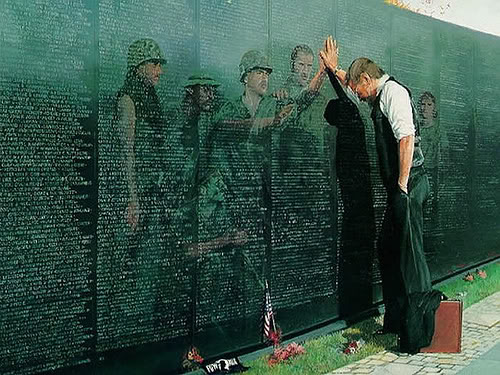Architecture: The Vietnam Veterans Memorial

James Kilpatrick wrote, Nothing I had heard of or written had prepared me for the moment. There are the names. The names! I could not speak. I wept... Uploaded by i171photobucket.com.
I’ve listed this post under the heading of “Architecture”, but the Vietnam Veterans Memorial qualifies as a Great American Thing on many levels. Its wall, listing the names of those who died in the Vietnam War, is one of America’s most emotional sites. Perhaps the only place that rivals it for emotional impact is Arlington National Cemetery.
The memorial has three parts. The first is the wall, the second is a statue (“Three Soldiers”) forced on the site as a political compromise by those who didn’t like the chosen design. And the third is the Vietnam Women’s Memorial, added a decade later in a pathetic attempt to be politically correct.
The Memorial Wall is composed of two black granite walls 246 ft. 9 in. long. The granite came from India, was cut in Vermont, and the names etched in Memphis. When people look at the names, their own image is reflected back, symbolically connecting the past and present.
The original design for the Memorial came out of an open competition, which drew 1,421 designs submissions. A jury of eight architects and sculptors unanimously chose the winner, created not by a world-class architect, but by a 21-year-old architecture student at Yale named Maya Lin. Many veterans groups initially opposed Lin’s design, but once construction was complete, all opposition dissipated due to the intensity of the experience it engendered.
I’ve never forgotten what columnist James J. Kilpatrick wrote after his first visit to the Memorial. “We walked, and gradually the long walls of the monument came into view. Nothing I had heard of or written prepared me for the moment. There are the names. The names! I could not speak. I wept. This memorial has a pile driver’s impact.”
[youtube=http://www.youtube.com/watch?v=6I4xlguA-OE]

